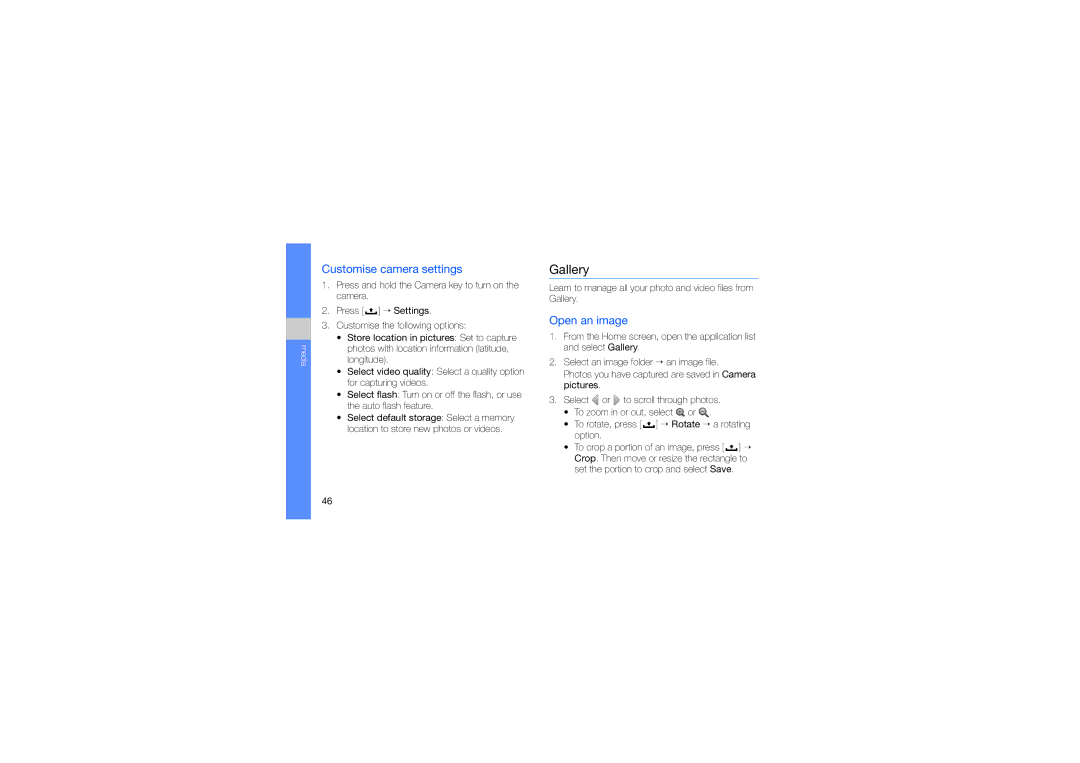Page
Using this manual
Instructional icons
Copyright information
Iii
Contents
Download applications from
Settings
Keep your device away from small children and pets
Safety warnings
Protect your hearing
Handle and dispose of batteries and chargers with care
Install mobile devices and equipment with caution
Avoid interference with pacemakers
Safety precautions
Turn off the device in potentially explosive environments
Reduce the risk of repetitive motion injuries
Do not use the phone if the screen is cracked or broken
Follow all safety warnings and regulations
Use only Samsung-approved accessories
Never use a damaged charger or battery
Turn off the device near medical equipment
Handle your device carefully and sensibly
Avoid interference with other electronic devices
Allow only qualified personnel to service your device
Ensure maximum battery and charger life
Important usage information
Use your device in the normal position
Ensure access to emergency services
Specific Absorption Rate SAR certification information
Correct disposal of this product
Correct disposal of batteries in this product
Disclaimer
Safety and usage information
Introducing your device
Unpack
Rear of your device includes the following keys and features
Device layout
Keys
Icons
Learn about the icons that appear on your screen
Icon Definition
Install the SIM card and battery
Assemble and prepare your mobile device
Getting started with your device
Charge the battery
Insert the battery Replace the battery cover
Insert a memory card optional
Getting started with your device
Turn your device on and off
Lock or unlock the touch screen and keys
→ Airplane mode
Disable wireless functions
Use the touch screen
Getting started with your device
Get to know the Home screen
Scroll through the Home screen
Add items to the Home screen
Application tab
Access applications
Move items on the Home screen
Remove items from the Home screen
View network information and notifications
Adjust the volume of the ringtones
Switch to or from the silent mode
Customise your device
Turn on or off the touch tone
Activate animation for switching windows
Enter text using the Android keyboard
Enter text
Set an unlock pattern
Copy and paste text
You can also use the following icons
Uninstall applications
Install applications
Download applications from Android Market
Download files from the web
Download files from the web
View the download history
→ Applications → Unknown sources
Activate automatic sync
Synchronise data
Select Auto-sync
Synchronise data manually
Make a call
Calls
Learn to make or answer calls and use call functions
Adjust the volume
Use the speakerphone feature
Answer a call
View and dial missed calls
Call an international number
Call a contact from Contacts
Hold a call or retrieve a held call
Dial a second call
Answer a second call
Make a multiparty call conference call
Send a text message
Text and multimedia messages
Send a multimedia message
Google Mail
View text or multimedia messages
View email messages
Organise email by labels
Set up a POP3 or Imap account
Email messages
Send an email message
Learn to send or view email messages
View email messages
Google Talk
Delete an email account
Start a chat
Add friends to your Friends list
Supported file formats
Your device supports the following file formats
Learn how to listen to music via the music player
Music
Add music files to your device
Play music files
Videos
Use the party shuffle feature
Create a playlist
Capture photos
Camera
Capture videos
Customise camera settings
Gallery
Open an image
Learn to manage all your photo and video files from Gallery
Play a slideshow
Open a video
Share images or videos
Watch videos
YouTube
Share videos
Contacts
Create a contact
Import contacts from the SIM card
Find a contact
Filter contacts by group
Set up a favourite contact list
Set contact groups for synchronisation
Calendar
Change the calendar view
View multiple calendars
Create an event
View today’s schedule
When you are finished, select Save
View event reminders
Browser
Learn to access and bookmark your favourite web pages
Browse web pages
Open multiple pages
To reload a web page, press → Refresh
Search for text on a web
Bookmark your favourite web pages
Copy text from a web
While browsing web pages, press → More → Select text
Google Search
Google Maps
Change the map view
Search the map
Search for a specific location
Find your location
Get directions to a specific destination
Bluetooth
Turn on the Bluetooth wireless feature
Find and pair with other Bluetooth- enabled devices
Select Bluetooth to turn on the Bluetooth wireless feature
Wi-Fi
Allow other Bluetooth devices to locate your device
Activate and connect to a Wlan
Add a Wlan
Alarm Clock
Set a new alarm
Stop an alarm
Delete an alarm
Calculator
To use the advanced operators, press → Advanced panel
Wireless controls
Wi-Fi
Change the settings for wireless network connections
Turn the Wlan feature on or off
Wi-Fi settings
Bluetooth
Bluetooth settings
Airplane mode
Call settings
Sound & display
Data synchronization
Security & location
Visible passwords
Applications
Unknown sources
Manage applications
SD card & phone storage
Date & time
Locale & text
Select locale
About phone
User dictionary
Troubleshooting
You forgot a PIN or PUK
If using a headset, ensure that it is properly connected
Sound quality of a call is poor
You cannot find a Bluetooth-enabled device
Ensure that your device is connected to the headset
Installing Low battery indicator
Connecting to other devices Visibility setting
Market Downloading from web, 30 viewing history
Finding
Viewing
Setting up accounts, 39 viewing
Playing slideshows, 47 viewing
Copy and paste, 28 entering, 27 messages
Manually
Sharing, 48 viewing, 44
Declaration of Conformity R&TTE
English EU.10/2009. Rev

